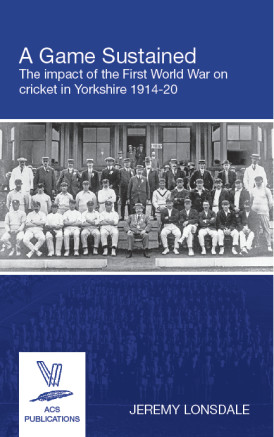A Game Sustained
Martin Chandler |Published: 2019
Pages: 195
Author: Lonsdale, Jeremy
Publisher: ACS
Rating: 4 stars

With the publication of A Game Sustained Jeremy Lonsdale makes it three in three years as far as books on Yorkshire cricket are concerned, all three published by the ACS. The first, in 2017, was A Game Taken Seriously, a book which I enjoyed, but its being long listed for the Cricket Society/MCC Book of the Year still took me a little by surprise. On the other hand the book being short listed for a rather more specialist award, the Lord Aberdare Literary Prize for Sports History, seems entirely appropriate.
Having examined cricket in Yorkshire between 1822 and 1893 in A Game Taken Seriously Lonsdale then made a contribution to the impressive Lives in Cricket series with a biography of Tom Emmett, one of the men who played a significant role in A Game Taken Seriously. Now, having sidestepped the Golden Age, Lonsdale has moved on to the years between 1914 and 1920, covering cricket in Yorkshire through the Great War and in its immediate aftermath.
By dint of the time that has passed since the era they cover both those earlier titles contain as much social as cricketing history, and it is the quality of the research into that that helps make both the satisfying reads they are. By moving onto 1914 aspects of political and military history loom larger and that setting is a very different one and, certainly for this reviewer, a rather more interesting one.
Early on in A Game Sustained Lonsdale quotes the oft repeated contemporary exhortation of WG Grace that it is not fitting at a time like the present that able-bodied men should play day after day and pleasure-seekers look on. At the same time, and a subject already dealt with in another book published by the ACS (Tony Barker’s Cricket’s Wartime Sanctuary) is the willingness of the Yorkshire Leagues, particularly the Bradford League, to put on a show. Men like Sydney Barnes, Jack Hobbs, Frank Woolley and George Gunn all plied their cricketing trade in Yorkshire during the years of the Great War.
It is probably as a result of having lived through a period of, essentially, peace, that I have never found it necessary to come to a firm conclusion on that particular dichotomy. I can see the merit in both schools of thought, and did hope that perhaps A Game Sustained would help me make a decision. In a sense Lonsdale’s wide ranging research did enable me to do that, although I largely remain on the fence. In the immediate aftermath of the declaration of war I think Grace was right, but equally when it became clear the conflict was going to be protracted then it seems to me there was a compelling case for sustaining some vestige of pre-war normality.
There are some remarkable statistics in A Game Sustained which, in this day and age, are difficult to comprehend. The UK alone mobilised as many as six million, forty per cent of whom ended up becoming casualties on some level, and of those as many as 720,000 made the ultimate sacrifice. I did know there had, in the aftermath of the declaration of war, been a rush to arms, but not that that was with such enthusiasm that on a single day in September 1914 as many as 33,000 men volunteered for military service.
Much of Lonsdale’s material has come from local newspapers in Yorkshire, and he has also had access to the Yorkshire county club’s archives. A couple of other historians have provided him with the fruits of their research as well, and the final result is a well written narrative taking the reader on a chronological journey through one of the most turbulent periods in world history. There is plenty of cricket, all put firmly in the context of the times. One excellent feature of the book is that it goes those two years beyond the armistice and covers that strange summer of two day Championship matches in 1919, and the prompt return to normality in the First Class game in 1920 as well as the game’s recovery at its less rarefied levels.
Having given A Game Taken Seriously three stars, and indeed Tom Emmett, I have decided to give four to A Game Sustained. This is not so much because the book is significantly better than its predecessors, but it is certainly more compelling. One other observation is in relation to the photographs. I was sufficiently impressed with those in A Game Taken Seriously to make specific mention, and I do so again here. Clearly those used have been chosen by Lonsdale, but what can’t have started as the best quality images have been reproduced extremely well so, be it printer, publisher or both particular credit is also due to whoever is responsible for that aspect of the book’s production.







Leave a comment